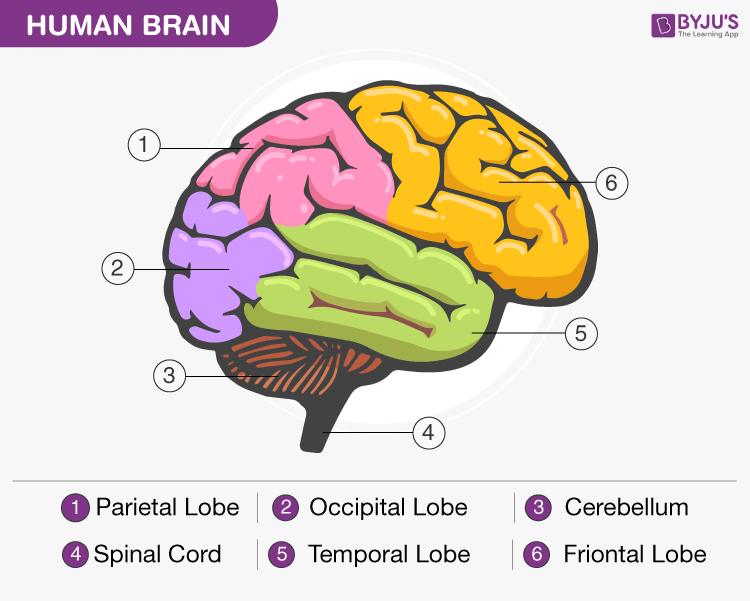Table of Contents
The Human Brain
The brain is the centre of our thoughts and the central organ of the human nervous system. It is the most complex and important organ in the body, which is made up of more than 100 billion specialized nerves and functions by controlling all the metabolic functions of our body.
The human brain is located in the head and enclosed within the skull, which provides frontal, lateral and dorsal protection. There are only a few creatures without having a brain. We cannot live without the brain, as it is mainly responsible for thoughts, interpretation and control for body movements. It also functions as the coordinating centre of intellectual, sensation and the nervous system.
The diagram of the brain is useful for both Class 10 and 12. It is one among the few topics having the highest weightage of marks and is frequently asked in the examinations. A well-labelled diagram of a human brain is given below for further reference.
Structure And Function Of The Human Brain

Parts Of The Human Brain
The human brain is divided into three main parts:
- Forebrain.
- Midbrain.
- Hindbrain.
These three main parts comprises many small parts.
Forebrain
The forebrain is also called as Prosencephalon.
The forebrain is the anterior part of the brain, which comprises the cerebral hemispheres, the thalamus, and the hypothalamus. It also consists of two subdivisions called the telencephalon and diencephalon. Along with the optic nerves and cranial nerves, the forebrain also includes the olfactory system, or sense of smell as well as the lateral and third cerebral ventricles.
The cerebrum is the largest part, which occupies two-thirds of the brain’s volume and covers most other brain structures. It is involved in controlling the major functions like our learning ability and emotions.
The cerebrum consists of the cerebral cortex and other subcortical structures. It is composed of two cerebral hemispheres that are joined together by C-shaped nerve fibre called the corpus callosum.
The cerebrum is further divided into four sub-sections or lobes:
- The Frontal Lobe
The frontal lobe is found just below the forehead. It is mainly responsible for the parts of speech, judgments, reasoning, solving problems, planning and for motor functions including movements. The frontal lobe is also associated with the self-regulated behaviours, facial expressions, controlling inhibition, to pay attention, to remember and to control emotions.
- The Parietal Lobe
The parietal lobe is found at the upper back of our brain. This lobe functions by controlling all our complex behaviours, including senses of vision, the sense of touch, spatial orientation and body awareness. It manages body position, movements, the perception of stimuli, orientation, handwriting and visuospatial processing.
- The Occipital Lobe
The occipital lobe is found at the back. It is mainly associated with visual processing systems such as body postures, gestures and expressions.
- The Temporal Lobe
The temporal lobe is found near to our ears and is associated with the speech, hearing, recognition and processing of auditory stimuli.
Midbrain
The midbrain is also called as Mesencephalon.
The midbrain is the smallest region of the brain, found at the centre of the brain, between cerebral cortex and hindbrain. It comprises tectum, cerebral peduncle, tegmentum, cerebral aqueduct, substantia nigra, several nuclei and fasciculi.
The midbrain is responsible for hearing, vision, sleep cycle, temperature regulation, alertness, etc. It contains a large number of dopamine-producing neurons in the substantia nigra, degeneration of these neurons is related to Parkinson’s disease.
Hindbrain
The hindbrain is also called as Rhombencephalon.
The hindbrain is located at the lower back part of the brain. It is mainly composed of the Cerebellum, brain Stem, pons and the medulla.
The cerebellum controls activities such as balance, coordination and muscle movements. The cerebellum is present at the backside of the brain at the base. The cerebellum is responsible for coordination and balance.
This was a brief introduction to Diagram Of Brain. For more information about Brain, its structure, functions and other related topics, visit us at BYJU’S Biology.

Comments